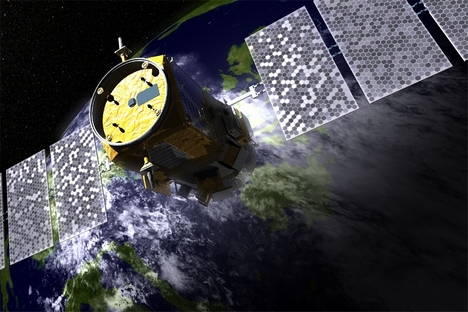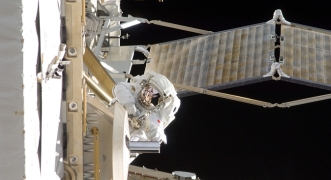Russia’s military looks to outer space

In March 2014 Russia is expecting its first launches of military spacecraft, which were delayed for several years for technical reasons. Source: NASA
Along with the general reform of the space industry, Russia plans to qualitatively increase the space military forces to improve the strategic nuclear missiles and capacity building of precision-guided conventional means.
President Vladimir Putin said in a late November defense meeting that orbital space grouping has grown considerably with five spacecraft joining this year and five more scheduled to launch before the end of this year. Next year six new spacecraft will be put into orbit as well as a trial launch of modern rocket Angara.
In March 2014 Russia is expecting its first launches of military spacecraft, which were delayed for several years for technical reasons. In addition, construction will begin of terrestrial infrastructures. According to preliminary estimates, this is expected to cost several trillion rubles up to 2020.
The current situation and trends of new military conflicts suggest that known presentations of combat operations are obsolete. The aim of the war of the future is not conquering of enemy territory, but applying verified attacks on its weak spots.
The massive use of ground troops based on armored vehicles are ideas of the past, and the role of strategic aviation has been reduced. The emphasis in the concept of "strategic weapons" has shifted from the classical "nuclear triad" to non-nuclear facilities based on high-precision weapon systems of various modes.
This in turn implies the existence of a large number of orbiters providing satellite reconnaissance, warning, forecasting and targeting systems, which are themselves in need of protection and defense.
According to General Vladimir Slipchenko, a military analyst, we should expect that in the current decade the number of precision-guided weapons in the leading countries of the world will reach 30,000 to 50,000, and in 2020 it will reach 70,000 to 90,000.
One can only imagine the number of satellite systems needed to provide them. And without them, every missile and "smart bomb" that can strike a mosquito becomes a useless iron.
Thus, hundreds of seemingly harmless "passive" spacecraft, which are themselves not attack systems, are in fact an integral part of the main weapons of the 21st Century – precision-guided weapons.
But the long-standing armed nuclear missile systems now cannot be effective without enough space information support, based on communication satellites and the satellites of missile warning systems.
One of the main developers of the Russian strategic missile systems, the director of the Moscow Institute of Heat Engineering Yuri Solomonov, believes that "the creation of advanced strategic complexes is unthinkable without their adaptability to the conditions of the full deployment of missile defense systems, including space-based elements."
This implies at least three conclusions. First, rocket and nuclear power should have a powerful satellite data ware constellation. Second, it needs to deploy its own missile defense system active agents. Third, it needs to function as a single organism, with the aim to protect the country from the strategic offensive weapons.
Does it follow from this that the militarization of space, which is due to the need to protect the satellite constellations and groups, is only a matter of time? If we keep in mind the deployment of near-Earth space strike weapons capable of hitting targets in space on their own, in the atmosphere and on Earth, then the answer is yes.
In this case, the space becomes a "turret" holding at gunpoint the entire planet.
However, it is not necessary to place in orbit battle stations or arm, for example, intelligence or meteorological satellites. Tasks of satellite protection could successfully be tackled by means of ground-based systems created in the Russian aerospace defense.
All rights reserved by Rossiyskaya Gazeta.
Subscribe
to our newsletter!
Get the week's best stories straight to your inbox

